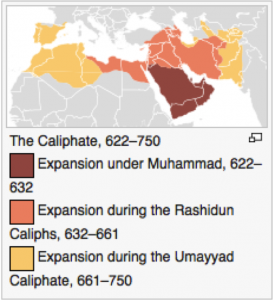Introduction
 During the Umayyad Caliphate Islam was brought to Morocco. By 740AD Morocco had gained independence from the Eastern Umayyad Caliphate and the Moroccan dynasties emerged. The first of these dynasties, the Idrissid (789-974 AD), was ruled by Islamized Amazigh or had Amazigh influence. The second and third dynasties, the Almoravid (1060-1147 AD) and the Almohad (1145-1269 AD) were purist in religious practice and focused specifically on the separation of the sexes. It was during this time that the fate was sealed for the second-class citizenship of Moroccan women.
During the Umayyad Caliphate Islam was brought to Morocco. By 740AD Morocco had gained independence from the Eastern Umayyad Caliphate and the Moroccan dynasties emerged. The first of these dynasties, the Idrissid (789-974 AD), was ruled by Islamized Amazigh or had Amazigh influence. The second and third dynasties, the Almoravid (1060-1147 AD) and the Almohad (1145-1269 AD) were purist in religious practice and focused specifically on the separation of the sexes. It was during this time that the fate was sealed for the second-class citizenship of Moroccan women.
Prior to the 11th century Islam’s foundations emphasized the sacredness of balance; one must have balance to function properly and thus every human being must be treated equal, regardless of race/ethnicity, class, gender, etc. (Dr. Sophia Rose Arjana). The Qur’an, or sacred text, was the basis for these values that were revealed to Muhammad by God from 609-632 AD.
Gender in the Qur’an
The Qur’an specifically describes both women and men as “khalifa of the earth” or co-rulers. Thus women and men are complimentary to one another and neither has more power/rights than the other. Indeed, one of the major values of Islam is equality (musawah) (Dr. Zainab Alwani). “The Believers, men and women, are protectors, one of another: they enjoin what is just and forbid what is evil: they observe regular prayers, practice regular charity, and obey God and His Apostle. On them God pour His mercy: For God is Exalted in power, Wise” (Sura 9, al-Tauba or al-Baraat: Verse 71).
Feminist scholars specifically point to any gender inequalities in the Qur’an as reflecting 7th century Arabian cultural values that do fit the needs of women and men in the current context. Further, they claim that most inequalities result from misreadings of the Qur’an as a result of a patriarchal structure. Dr. Amina Wadud, for example, has dedicated much of her scholarly works to explaining the ways in which the Qur’an may be used to support a more gender egalitarian society. She specifically notes the complex nature of Arabic and the consequent tragic misreadings that result in oppressive laws and practices. For instance, many men have read this excerpt in ways that fit the already enforced patriarchal structure:
“As to those women on whose part ye disloyalty and ill-conduct admonish them (first), (next), refuse to share their beds, (and last) beat them (lightly)” (4:34).
Wadud explains, however, that the word most often mistranslated to “beat” (darab) actually has 30 different meanings, one of which is “separate.” Thus, a second interpretation of this excerpt could be:
“As to those women on whose part ye disloyalty and ill-conduct admonish them (first), (next), refuse to share their beds, (and last) separate from them (for a short time)” (4:34).
The interpretations of the Qur’an can therefore be plentiful and must be specific to the cultural context.
Influential Moroccan Women Activity
The Sufi (an Islamic sect) have a saint culture in which saints are the focus of prayers and practices (e.g., festivals/celebrations). Some of these saints are women found in the Qur’an. Other women within the Qur’an were not officially canonized yet they play very important roles in teaching Muslims about the values of Islam.
Instructions
- Divide students in pairs
- Assign each pair an influential woman from the Qur’an (i.e., Hawwa, Wā‘ila, Khadija, Asijay, Fatima, Aisha) and influential Sufi saints (i.e., Rabi’a al-‘Adawiya, Rabi’a al-Badawiya)
- Ask students to conduct in-class (online) or library research on their assigned woman.
- Students should find out:
- Who was this woman (where was she born or where did she live? When was she born?)
- What role did this woman have in Islam (was her story utilized to tell something good or bad about women’s role? How was her story used to encourage/control Islamic women?)
- Whether this woman’s story has influence in Morocco today.
- Students will share what they find with the class. The class will discuss whether religious figures have the power to shift cultural understandings of gender roles and whether individuals within each culture have the power to shift views about the gendering of religious figures.
A more in-depth explanations of women’s roles in Islam and contemporary concerns for Moroccan women are presented in the next section on sexuality and identity.